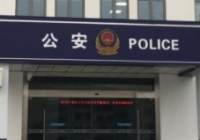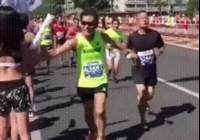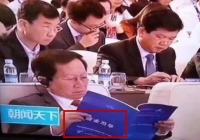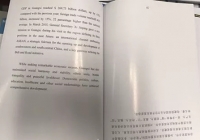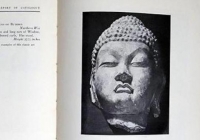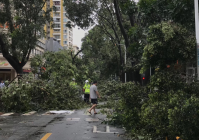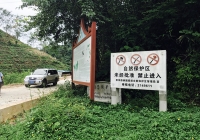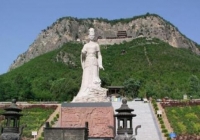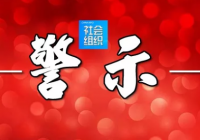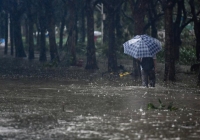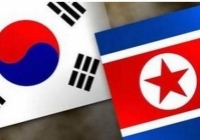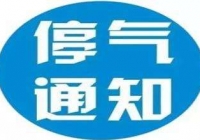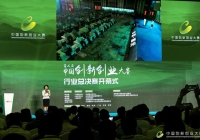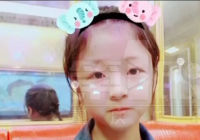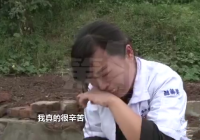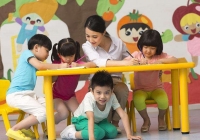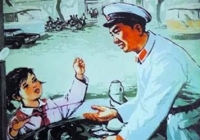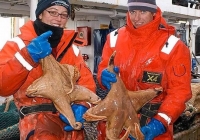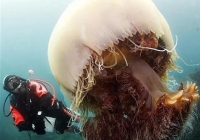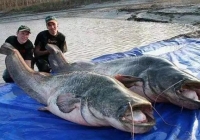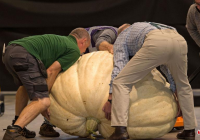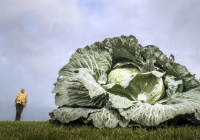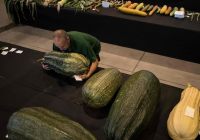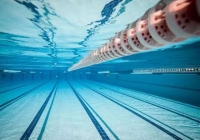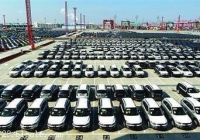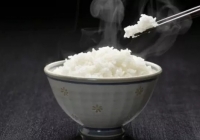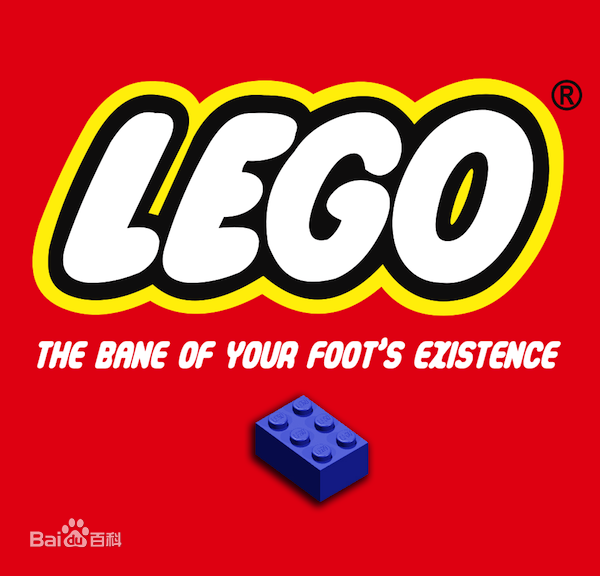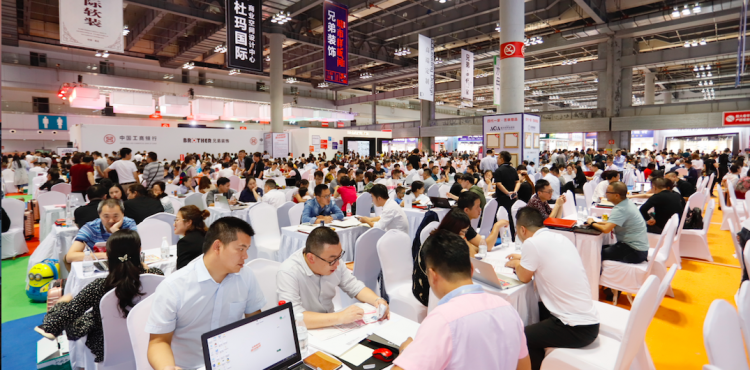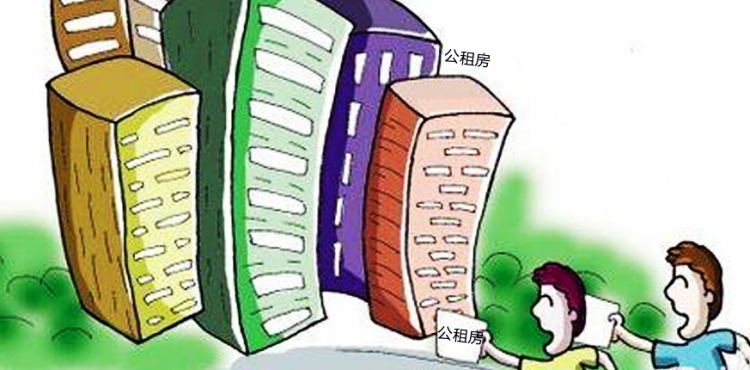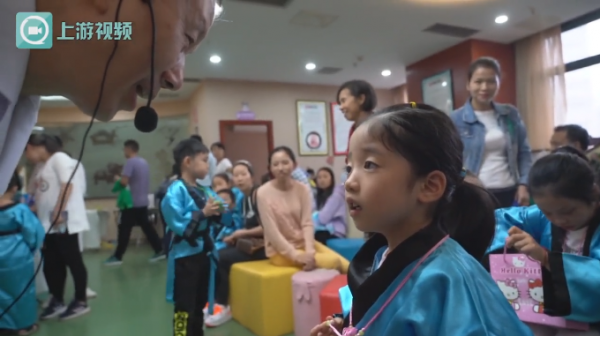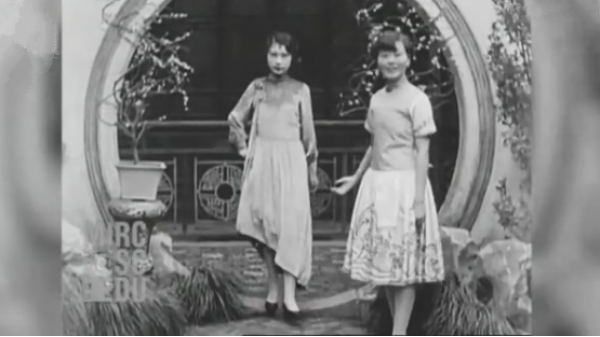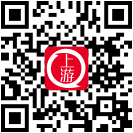

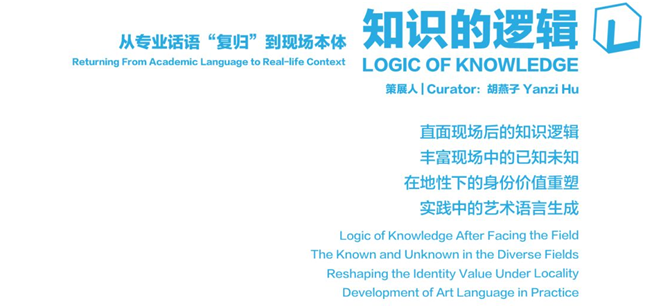
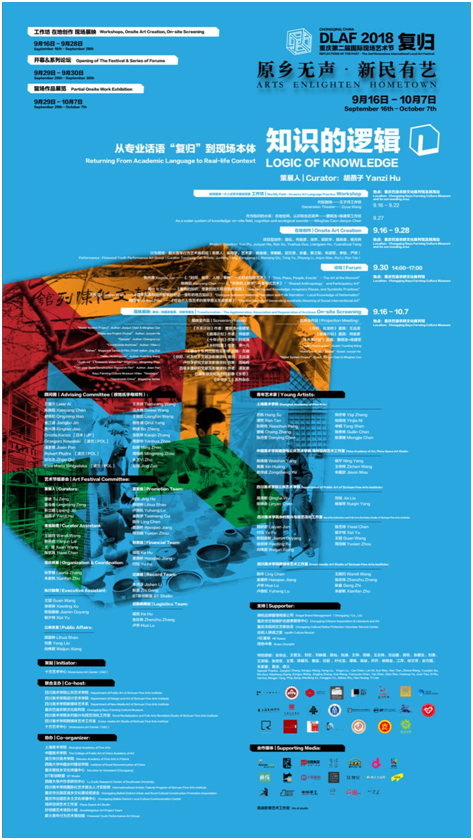

从远古人猿进化出超常的脑容量开始,似乎就意味着这种自称为“人类”的物种要开始构建一个叫“知识”的系统了。也许我们的讨论可以尝试从这个系统的生成方式开始:
知识的集聚:人类面对广袤的未知、分析收集整合信息,逐渐生成知识体系;知识体系不断地丰富,进而出现不同学科、不同领域的差异与互补。即人类面对、观看、记录、总结世界的过程。
知识的内生:人类基于已有知识,在知识系统内部的衍生与推导。包含3方面:1.分化,从核心主干知识系统派生出丰富的分系统。2.交互,不同的知识系统之间跨界、交互、互鉴形成知识网络,交互的过程中生成新的知识内容。3.审视,人类对自身已有知识内容的反观与批判。进而进行矫正或新的推导产生的知识系统。
知识的复归:人类基于已有的知识系统,重新回到现场、面对现场,同时通过观察、讨论、行动等方式作用于现场。使已有知识与现场发生深度交互,进而产生新的知识的过程。这个过程既接引知识的新的集聚,又呼应知识的内生。
通常情况下,以上三个环节是在人类的知识大现场中同时发生、互相促进的。
因此,当我们讨论专业话语复归现场本体的时候,实际上是尊重知识的生成逻辑,面对世界回到现场作用于现场,在知识系统内部推导的同时,接引知识新的集聚。
艺术语言作为人类知识系统的一种,自然也在不断的发生着集聚、内生与复归。当艺术专业话语“复归”现场,面对现场展开工作,不仅是一种获取信息讨论问题的方法,也是生成新语言的路径。而历史长河中那些闪耀着智慧光芒和创造力的人,无一不是敏锐而勇敢的面对着自己所处的时代现场展开思考并做出回应。丰富的现场中包含一切已知,和一切未知。那是艺术创造的源动力。
现代主义、后现代主义以后,艺术边界越来越模糊,学科之间的跨界越来越多。有的在跨界中生成新的语言,有的在跨界中生成新的观念。语言是为了沟通而存在,语言的生成与沟通对象和沟通工具息息相关。观念来自于我们所面对的世界,以及对世界进行的价值判断。时代在演变,人与人之间的社群关系、伦理关系、相处模式都在发生变化。世界变了,观念和语言自然也随之而发生变化。今天,艺术工作者不再局限于再现、说明和描述社会,而希望能够直接介入社会中,成为社会结构的一部分。随着艺术介入社会的案例不断增加,我们会经常看到“社会介入性艺术”、“公共艺术”、“社区艺术”、“参与式艺术”等描述和分类的方式。这已充分说明,在当代艺术中,艺术家对于现场本体的复归已经大规模展开。
基于材料和形式讨论艺术的时代早已远去,基于语言和观念的分类也已经越来越模糊,我们需要展开的,是面对当下现场的,对于艺术本体价值的再思考。
那么我们究竟处于怎样的现场?
在资本、技术和政治格局的推动下,世界现场在凶猛而无序的改变着。受西方现代化进程的影响,辛亥革命以来,中国国家层面在外部力量的震荡下不得不迅猛的推进工业化、城镇化、现代化进程。在此过程中,与纵横捭阖的国际发展策略、引人瞩目的经济发展速度相对应的,是对地方性问题的粗糙的、简单化的解决方式。国家制定的宏观层面政策无法兼顾每一个地方独特的丰富的在地性,国家层面和地方层面之间有待建立更有效的互动方式。中国传统社会中地方发展所依靠的“宗法”“乡绅”“风俗”系统几无所存,基于生产方式、血缘关系、自然规律、儒家文化等建立起来的民间传统知识系统已经碎片化,乡村现场整体呈现一种缓慢的系统性的崩溃。
此种情境下,艺术面对的现场与人类学、社会学、政治哲学、科学等学科所面临的现场事实上是同一个现场,那么艺术当如何与其他学科之间建立合作与对话?该如何对艺术的本体价值进行再思考?面对民间知识系统的碎片化,艺术的参与能否起到一定的弥合作用?很多先行者已经开始了他们的行动和观察。田野调查、在地创作、影像档案、乡村美术馆、社区剧场... ...每一个进入现场的人都有自己的认识和方法,人们应当聚在一起,去呈现不同的方法和判断,去展示这种丰富性,同时促成不同群体之间的对话,使思想流动,最终产生新的知识。
希望这次复归艺术节,成为思想流动、产生新知、弥合碎片的契机。
- 策展人 胡燕子
Beginning with the evolution of extraordinary brain capacity from ancient humans, it seems that this kind of self-proclaimed "human" has begun to build a system called "knowledge." We can start discussion from how this system is generated:
The agglomeration of knowledge: Human beings face the vast unknown, analyze and collect integrated information, and gradually develop knowledge systems. The knowledge system is continuously enriched, certified and complemented in the process of combining different disciplines and fields. That is, the process of human beings facing, watching, recording, and summarizing the world.
The self-evolvement of knowledge: the ability of human beings to process and deduce the knowledge system into self-evolvement. It consists of three aspects: 1. Differentiation: the knowledge derives a rich subsystem from the core stem knowledge system. 2. Interaction: different knowledge systems of cross-boundary, interactive, mutual authentication to form a knowledge network, and generate new knowledge content in the process of interaction. 3. Examination: human beings reflect and criticize their own knowledge content. Further, the knowledge system is rectified over and over in the process of correction and derivation.
The return of knowledge: Based on the existing knowledge system, human beings return to the field and face the field, and at the same time interact and impose impact on the field through observation, discussion and action. The process of creating new knowledge in the process of interacting with existing knowledge. This process includes both new agglomerations of knowledge and the self-evolvement of knowledge.
Usually, the above three parts are simultaneously and mutually promoted in the human knowledge field background.
Therefore, when we discuss the return from professional jargons to the on-site fields, we should respect the logic of knowledge generating. When we return to the field and act on the field, we can receive new agglomerations of knowledge in the process of self-evolvement of knowledge. As part of human knowledge system, artistic language is also in the process of constant agglomerations, self-evolvement and returning. When the art profession "returns" to the field, it is not only a method to get information and discuss problems, but also a path to generate new languages. Those who shine with wisdom and creativity in the long river of history are all keen and brave to think and respond to the fields of their own time. The rich field contains everything known, and everything unknown. That is the fountain of artistic creation.
After modernism and postmodernism, the boundaries of art are becoming more and more blurred. Cross-disciplines get more popular, generating new languages in some case or new concept in other cases. Language exists for communication and language is closely related to communication targets and communication tools. Concepts come from the world we are in and the value judgments we make about the world. The times are evolving, and the social, ethical, and coexistence patterns between people are changing. The world has changed, and so does the concepts and language.Today, art workers are no longer limited to reproducing, explaining, and describing society, but to directly intervene in society and become part of the social structure. As the amount of art interventions in society continues to increase, we will often see more often the description and classification of “social interventional art”, “public art”, “community art”, and “participatory art”. This has fully demonstrated that in contemporary art, a large scale of artist's return to the on-site field has been kicked off.
The era of discussing art based on materials and forms has long since passed, and the classification based on language and concept has become increasingly blurred. What we need to develop is to face the current situation and fields and rethink the value of art itself.
So what exactly is the field we are int?
Driven by capital, technology and political patterns, the world has changed fiercely and disorderly. Affected by the process of Western modernization, since the Revolution of 1911, China has been pushed to rapidly advance the process of industrialization, urbanization, and modernization under the menace of external forces. In contrasts, the methods the locality employs to solve problems seemed simple and brutal, compared with the sophisticated development of international strategy and the rapid economic development. The rigid macro development policy on national level can hardly take into account the unique features of locality. The dialogue mechanism between central government the local regions was not well established. The above two points resulted in the disorder of current social structure. The traditional folk knowledge system based on production methods, blood relationship, natural laws, Confucian culture, etc. has been fragmented and reduced, presenting a slow but systematic crackdown.
Under such circumstances, the field faced by art is shared simultaneously by anthropology, sociology, political philosophy, science and other disciplines. How can art establish cooperation and dialogue mechanism with other disciplines? How to reassess the value of art itself? In face of the fragmentation of the folk knowledge system, can art intervention play a certain role in amelioration? Many pioneers have already begun in actions and observations. Field investigations, local creations, video archives, rural art museums, community theaters... Everyone who returns to the field has one’s own perspectives and methods. When people get together, using different methods and judgments to facilitate dialogue between different groups with rich angles, eventually new knowledge will be generated in the exchange of thoughts.
I hope that this Festival of Return will become an opportunity for the collision of ideas, creation of new knowledge, and bridging of gaps.
- Curator Yanzi Hu
分策展人介绍 | Curator Introduction
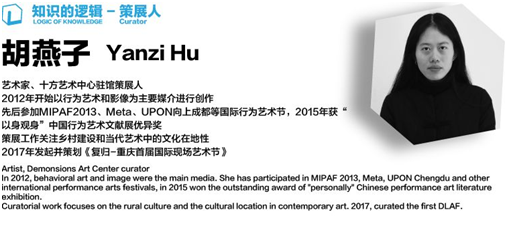
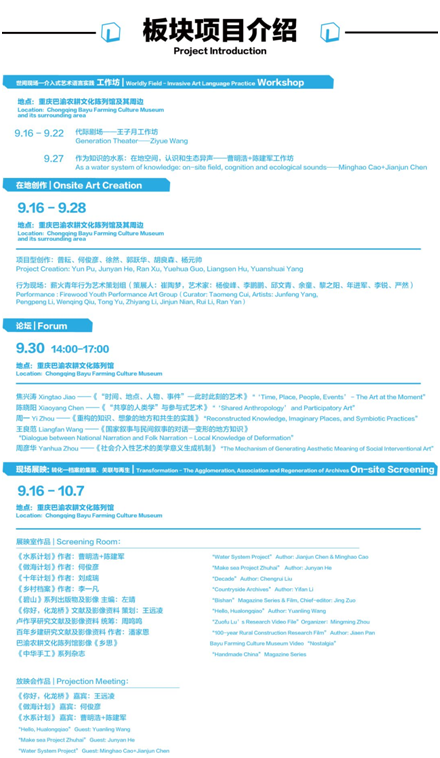

代际剧场——王子月工作坊
Generation Theater – Ziyue Wang
9.16 - 9.22
公众参与:定向式邀请。
Public participation: Invitation only.
工作坊推介 | Workshop Introduction:
在社会急剧变革时期,不同时代出生的人之间的隔阂和冲突与日俱增,我邀请在当地生活的民众进行为期一周的代际剧场工作坊,力图为各个年龄段的参与者提供一个信任和创造性的环境,希望寄予工作坊引导参与者来检视和分析现实生活中的问题和情况,在不同年龄的个人之间打破隔阂、激发出新的对话与再想象, 发展代际关系并创造共同的历史。
In the period of a rapid social change, the gap between one generation and another is like two parallel worlds. I want to invite local senior people and children to join in a week-long generation theater studio activity to guide the two generations to break through the barriers and carry out new interactions in a familiar field. It is hoped that people start to explore what kind of intergenerational relationship people have in the Southwest region and inspire new dialogue and imagination.
导师介绍 | Tutor Introduction:
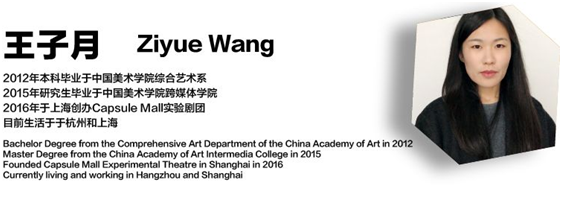
作为知识的水系:在地空间,认识和生态异声——陈建军&曹明浩工作坊
As a water system of knowledge: on-site field, cognition and ecological sounds - Jianjun Chen & Minghao Cao
9.27
公众参与:限额报名,后续将发布详细信息,敬请期待。
Public participation: Quota registration, detailed information will be released in the future, please stay tuned.
工作坊推介 | Workshop Introduction:
在很多时候,我们是由学习了经过归纳和概括的知识后,再去认识身边的事物。但现实的复杂与细节问题,已指出这并不是最好的实践路径。作为知识的水系,是从感性田野到在地的经验,过程中所经历的种种困惑、问题与反省,形成了我们理解的“知识”概念。这个部分的讨论,可以从前期开展合作的在地空间蕴含的潜质开始,和实践中对以往建立的水系生活模式的再提问来谈。如何在缓慢的创作里推进,经历错误,并提出对“水系”的审美思考?这样的认识,是我们在水系研究与创作中,另一种知识形成的必经之路。
In many cases, we learn about the things that have been summarized and summarized before we get to know things around us. But the complexity and details of reality have pointed out that this is not the best practice path. As the water system of knowledge, it is the experience from the emotional field to the local experience. The various puzzles, problems and reflections experienced in the process have formed the concept of "knowledge" that we understand. The discussion in this part can start from the potential of the space in the previous cooperation, and talk about the previous life style of the water system in practice. How to advance in slow creation, experience mistakes, and put forward aesthetic thinking about the "water system"? This kind of understanding is the only way for us to form another knowledge in the research and creation of water systems.
导师介绍 | Tutor Introduction:
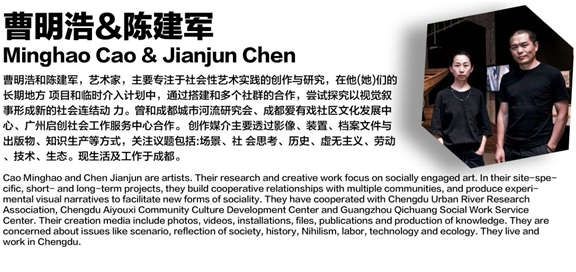

项目型创作:普耘、何俊彦、郭跃华、胡良森、杨元帅、徐然
Project Creation: Yun Pu, Junyan He, Yuehua Guo, Liangsen Hu, Yuanshuai Yang, Ran Xu
公众参与:艺术家完成在地创作后,将推出在地成果展,敬请期待。
Public participation: After the artist completes the onsite creation, we'll hold an exhibition, please stay tuned.
参与艺术家 | :


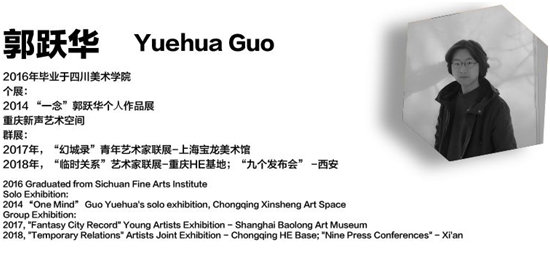
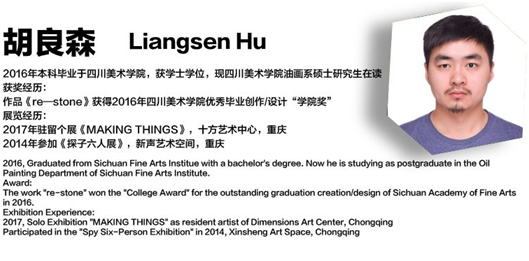


行为现场:薪火青年行为艺术策划组(策展人:崔陶梦,艺术家:杨俊峰、李鹏鹏、邱文青、余童、黎之阳、年进军、李锐、严然)
Performance: Firewood Youth Performance Art Group ( Curator:Taomeng Cui Artists: Junfeng Yang, Pengpeng Li, Wenqing Qiu, Tong Yu, Zhiyang Li, Jinjun Nian, Rui Li, Ran Yan )
公众参与:艺术家完成在地创作后,将推出在地成果展,敬请期待。
Public participation: After the artist completes the onsite creation, we'll hold an exhibition, please stay tuned.
薪火青年行为艺术策划组 | Firewood Youth Performance Art Group
薪火,是国内首次由四川美院新媒体艺术系在校学生自发组织的行为艺术现场,在全国各大美院里面实属首例,以自由开放的态度给青年艺术家提供一个可以交流、实施作品的和发声的平台。
我们以现场为主要形式,围绕青年艺术家,发现和展示中国行为艺术的新生力量,促成越来越多的优秀青年艺术家展开深度的合作与交流,对将来西南乃至全国行为艺术发展有深远意义。
自2013年创办至今,每年举办两次,从第一届开始至今,不断涌现很多热爱行为艺术并且坚持走下去的年轻艺术家,其中一些参加活动的重庆青年艺术家多次受邀参加北京、成都、澳门、西安、深圳、广州等地的国际行为艺术活动,在中国行为艺术文献展、新星星艺术奖、明天当代雕塑奖等奖项中入选或获奖。
The Firewood is the first behavioral art scene organized by the students of the New Media Art Department of Sichuan Academy of Fine Arts. It is unprecedented among the major art institutes across the country. It provides a platform with free and open attitude for young artists to communicate, create and speak.
With on-site performance as the main form, we hope to discover and demonstrate new force of Chinese behavior artists and encourage outstanding young artists to carry out in-depth cooperation and exchanges, which is of far-reaching significance for the future development of behavioral art in Southwest China and even the whole country.
Since the first Festival in 2013, there have been many young artists who love behavior art and want to keep going further. Some of the young artists from Chongqing have been invited to International Behavior Art Activities in Beijing, Chengdu, Macau, Xi'an, Shenzhen, Guangzhou and other places. Many of them were nominated or awarded with in the China Behavior Art Document Exhibition, the New Star Art Award Ceremony, and the Tomorrow Contemporary Sculpture Award Ceremony.
薪火青年行为艺术策划组 | Firewood Youth Performance Art Group:


“知识的逻辑” - 从专业话语“复归”到现场本体
Logics of Knowledges - “Returning” From The Profession to The On-site Context
公众参与:不限额公开参与。
Public participation: No limit public participation.
主持 Host:胡燕子 Yanzi Hu
演讲主题及嘉宾 | Presentation Theme&Guest:
焦兴涛 -《“时间、地点、人物、事件”—此时此刻的艺术》
陈晓阳 -《“共享的人类学”与参与式艺术》
周一 -《重构的知识、想象的地方和共生的实践》
王良范 -《国家叙事与民间叙事的对话—变形的地方知识》
周彦华 -《社会介入性艺术的美学意义生成机制》
Xingtao Jiao - “‘Time, Place, People, Events’ - The Art at the Moment”
Xiaoyang Chen - “‘Shared Anthropology’ and Participatory Art”
Yi Zhou - “Reconstructed Knowledge, Imaginary Places, and Symbiotic Practices”
Liangfan Wang - “Dialogue between National Narration and Folk Narration - Local Knowledge of Deformation”
Yanhua Zhou - “The Mechanism of Generating Aesthetic Meaning of Social Interventional Art”
论坛嘉宾介绍 | Forum Guests:
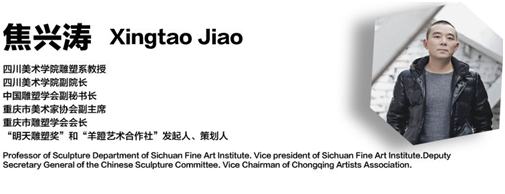


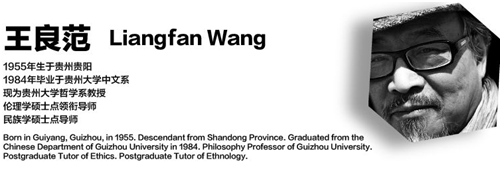


公众参与:不限额公开参与。
Public participation: No limit public participation.
本版块分为展映室、放映会两种内容形式。分为常态化和非常态化两种展示频率。主题是“转化--档案的集聚、关联与再生”,旨在展示“建立档案”这种常见而有效的工作方法在艺术现场中的案例,以及因其艺术语言的转化而展现出的,与普通档案不同的创造性、审美价值以及功能性上的拓展。同时与“巴渝农耕文化陈列馆”的档案化陈列内容相呼应相对比。
This section is divided into three parts according to contents: screening room, library room and screening session with regular or irregular in terms of display frequencies. The theme is “Transformation – Agglomeration, Correlation and Regeneration of Archives”, which aims to showcase the common and effective working methods of “building archives” in the art scene, as well as the transformation of its artistic language with different creative, aesthetic, and functional extensions that ordinary archives don’t have. At the same time, it corresponds to the archives displayed in the “Bayu Farming Culture Exhibition Hall”.
展映室作品 | Projection Room:
《水系计划》作者:曹明浩+陈建军
《做海计划》作者:何俊彦
《十年计划》作者:刘成瑞
《乡村档案》作者:李一凡
《碧山》系列出版物及影像 主编:左靖
《你好,化龙桥》文献及影像资料 策划:王远凌
卢作孚研究文献及影像资料 统筹:周鸣鸣
百年乡建研究文献及影像资料 作者:潘家恩
巴渝农耕文化陈列馆影像《乡思》
《中华手工》系列杂志
“Water System Project” Author: Jianjun Chen & Minghao Cao
“Make sea Project Zhuhai” Author: Junyan He
“Decade” Author: Chengrui Liu
“Countryside Archives” Author: Yifan Li
“Bishan” Magazine Series & Film, Chief-editor: Jing Zuo
“Hello, Hualongqiao” Author: Yuanling Wang
“Zuofu Lu’s Research Video File”Organizer:Mingming Zhou
“100-year Rural Construction Research Film” Author: Tiejun Wen, Jiaen Pan
Bayu Farming Culture Museum Video “Nostalgia”
“Handmade China” Magazine Series
放映会作品 | Projection meeting:
《你好,化龙桥》 嘉宾:王远凌
《做海计划》 嘉宾:何俊彦
《水系计划》 嘉宾:曹明浩+陈建军
“Hello, Hualongqiao” Guest: Yuanling Wang
“Make sea Project Zhuhai” Guest: Junyan He
“Water System Project” Guest: Jianjun Chen & Minghao Cao
作者介绍 | Author Introduction:
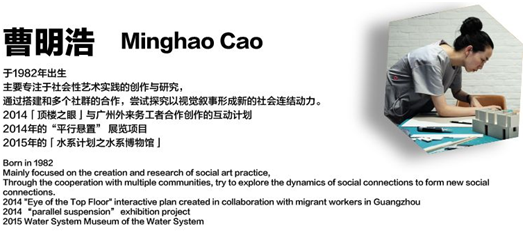



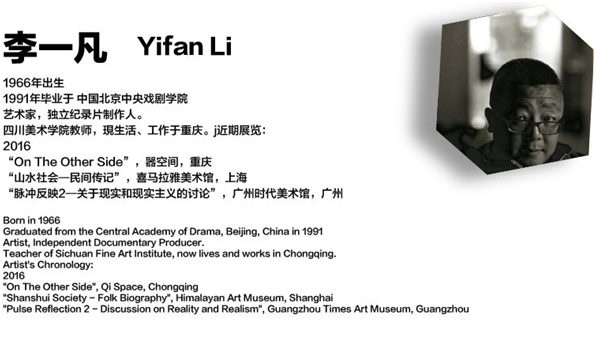
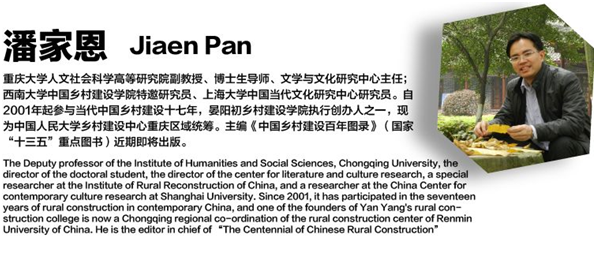

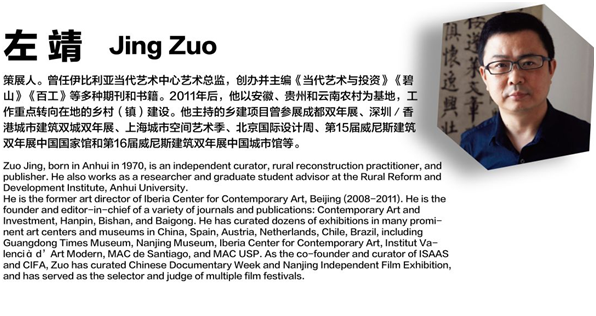
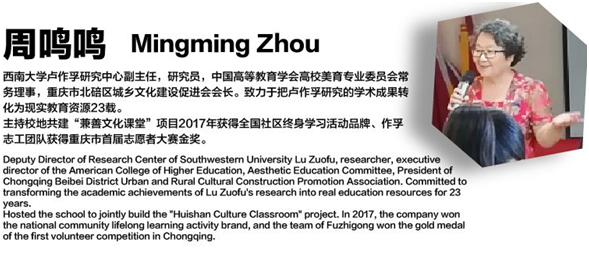
【免责声明】上游新闻客户端未标有“来源:上游新闻-重庆晨报”或“上游新闻LOGO、水印的文字、图片、音频视频等稿件均为转载稿。如转载稿涉及版权等问题,请与上游新闻联系。

